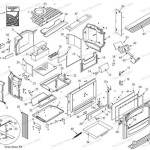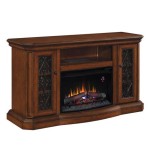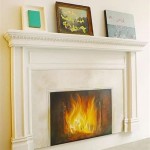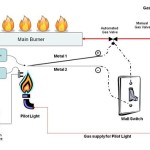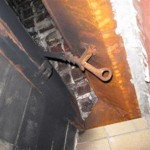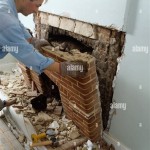Best Rated Electric Fireplaces: A Comprehensive Guide
Electric fireplaces have become increasingly popular as a convenient and efficient alternative to traditional wood-burning or gas fireplaces. They offer the ambiance and aesthetic appeal of a real fireplace without the associated mess, maintenance, and safety concerns. The market offers a diverse range of electric fireplaces, each with unique features, designs, and price points. Navigating these options can be challenging, making it crucial to understand the factors that contribute to a well-rated electric fireplace. This guide explores the key elements that define top-rated electric fireplaces, providing insights into their functionality, aesthetics, and overall value.
Understanding the Core Components of an Electric Fireplace
The performance and longevity of an electric fireplace are fundamentally tied to the quality of its core components. These include the heating element, the flame effect technology, and the overall build quality. A high-quality heating element, typically a ceramic or quartz infrared heater, will ensure efficient and consistent heat output, allowing for effective zone heating. The flame effect technology, which simulates the appearance of a real fire, is crucial for creating a realistic and visually appealing ambiance. Advanced models often employ LED lighting and sophisticated projection techniques to create a more dynamic and convincing flame.
Build quality is another critical factor to consider. A well-constructed electric fireplace will be more durable and resistant to wear and tear. The materials used in the construction, such as the frame, firebox, and glass screen, should be robust and long-lasting. The quality of the electronic components, including the thermostat and control panel, also plays a significant role in the overall reliability of the unit. Paying attention to these core components is essential for selecting an electric fireplace that will provide years of reliable performance and aesthetic enjoyment.
The heating element's efficiency is often measured in British Thermal Units (BTUs). A higher BTU rating indicates a greater heating capacity. However, it's important to consider the size of the room that the fireplace will be heating. Overheating can lead to discomfort and wasted energy. Most electric fireplaces are designed to heat rooms ranging from 400 to 1,000 square feet. The type of heater also affects the efficiency. Infrared heaters tend to be more efficient at heating objects directly, while convection heaters provide more even heat distribution throughout the room.
The flame effect is arguably the most important visual aspect of an electric fireplace. The realism of the flame is directly related to the technology used. Older models often used simple rotating reflectors and colored lights to create the illusion of a flame. Newer models employ sophisticated LED lighting and holographic projection techniques to create a more dynamic and realistic flame, often with adjustable brightness and color settings. Some models even include features like flickering embers and realistic log sets to further enhance the visual appeal.
The build quality of an electric fireplace directly impacts its lifespan and overall appearance. A solid frame, constructed from materials like steel or high-quality wood, will ensure stability and prevent warping or damage. The firebox, which houses the heating element and flame effect, should be made from durable materials that can withstand high temperatures. The glass screen should be tempered and heat-resistant to prevent shattering. The control panel should be user-friendly and responsive, with clearly labeled buttons or a touchscreen interface.
Assessing Key Features and Functionality
Beyond the core components, the features and functionality of an electric fireplace play a significant role in its overall rating. Key features include adjustable heat settings, a thermostat, a timer, a remote control, and safety features such as overheat protection. Adjustable heat settings allow users to customize the heat output to their desired level of comfort. A thermostat maintains a consistent room temperature by automatically cycling the heater on and off. A timer allows users to program the fireplace to turn on or off at specific times, conserving energy and providing added convenience.
A remote control provides convenient control over the fireplace from a distance, allowing users to adjust the heat settings, flame effect, and timer without having to get up. Safety features, such as overheat protection, are essential for preventing accidents and ensuring safe operation. Some models also include cool-touch housing, which prevents the exterior of the fireplace from becoming too hot to the touch. These features contribute to a more user-friendly, safer, and more energy-efficient experience.
The adjustable heat settings are crucial for personalizing the heating experience. Most electric fireplaces offer multiple heat settings, typically a low and high setting. This allows users to fine-tune the heat output to maintain a comfortable temperature in the room, regardless of the external conditions. A thermostat, in conjunction with the adjustable heat settings, automates this process by maintaining a consistent temperature, preventing overheating and saving energy.
The timer function adds another layer of convenience and energy efficiency. Users can program the fireplace to turn on before they arrive home or turn off after they go to bed, ensuring a warm and comfortable environment without wasting energy when the room is unoccupied. The remote control further enhances convenience by allowing users to adjust the heat settings, flame effect, and timer from anywhere in the room.
Safety features are paramount, especially in households with children or pets. Overheat protection automatically shuts off the fireplace if it detects excessive heat, preventing fires and damage to the unit. Cool-touch housing prevents the exterior of the fireplace from becoming dangerously hot, reducing the risk of burns. These safety features are essential for ensuring the safe and reliable operation of the electric fireplace.
Analyzing Aesthetic Design and Installation Options
The aesthetic design and installation options of an electric fireplace are crucial considerations, as they directly impact its visual appeal and suitability for different spaces. Electric fireplaces are available in a wide range of styles, from traditional mantel fireplaces to modern wall-mounted units and freestanding models. The choice of style will depend on the individual's taste and the overall decor of the room. The size and dimensions of the fireplace should also be carefully considered, ensuring that it fits comfortably within the available space.
Installation options vary depending on the type of electric fireplace. Mantel fireplaces typically require some assembly and are placed against a wall, while wall-mounted units are hung on the wall like a picture. Freestanding models are portable and can be moved from room to room. The installation process should be straightforward and require minimal tools or expertise. A well-designed electric fireplace will seamlessly integrate into the room's decor, enhancing its overall aesthetic appeal.
The style of the electric fireplace should complement the existing decor of the room. Traditional mantel fireplaces are often made from wood or stone and feature ornate detailing, making them well-suited for classic or rustic interiors. Modern wall-mounted units are typically sleek and minimalist, with clean lines and a contemporary finish, making them ideal for modern or minimalist spaces. Freestanding models offer versatility and can be placed in various locations, making them suitable for a wide range of decor styles.
The size and dimensions of the electric fireplace are also important considerations. A large mantel fireplace may overwhelm a small room, while a small wall-mounted unit may get lost in a large space. It's important to measure the available space and choose a fireplace that is appropriately sized. The depth of the fireplace should also be taken into account, especially for wall-mounted units, as they can protrude from the wall and take up valuable floor space.
The installation process should be relatively simple and straightforward. Mantel fireplaces typically require some assembly, but the instructions should be clear and easy to follow. Wall-mounted units require mounting brackets and may require drilling into the wall, so it's important to ensure that the wall is strong enough to support the weight of the unit. Freestanding models require no installation and can be simply plugged into a standard electrical outlet.
Ultimately, the best-rated electric fireplace will combine high-quality components, useful features, and an aesthetically pleasing design to provide a comfortable, safe, and visually appealing heating solution. Careful consideration of these factors will enable consumers to make informed decisions and select an electric fireplace that meets their individual needs and preferences.

9 Best Electric Fireplace Inserts Of 2024 Tested And Reviewed

ᑕ❶ᑐ Energy Efficient Electric Fireplaces For Your Home

Electric Fireplaces Direct The Fireplace Experts

9 Best Electric Fireplace Inserts Of 2024 Tested And Reviewed

ᑕ❶ᑐ The Best Electric Fireplaces To Buy Updated February 2024

The Best Electric Fireplace Inserts To Stay Cozy This Winter
The 10 Best Electric Fireplaces To Snuggle Up This Winter Yahoo Sports

The Best Electric Fireplaces In 2024 Popular Science

9 Best Electric Fireplace Inserts Of 2024 Tested And Reviewed

ᑕ❶ᑐ Top 5 Best Electric Fireplaces To Buy In 2024
Related Posts

